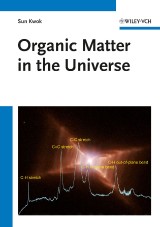Details

Organic Matter in the Universe
1. Aufl.
|
111,99 € |
|
| Verlag: | Wiley-VCH |
| Format: | EPUB |
| Veröffentl.: | 27.12.2011 |
| ISBN/EAN: | 9783527411191 |
| Sprache: | englisch |
| Anzahl Seiten: | 277 |
DRM-geschütztes eBook, Sie benötigen z.B. Adobe Digital Editions und eine Adobe ID zum Lesen.
Beschreibungen
Authored by an experienced writer and a well-known researcher of stellar evolution, interstellar matter and spectroscopy, this unique treatise on the formation and observation of organic compounds in space includes a spectroscopy refresher, as well as links to geological findings and finishes with the outlook for future astronomical facilities and solar system exploration missions. A whole section on laboratory simulations includes the Miller-Urey experiment and the ultraviolet photolysis of ices.
<br> <br> 1. History and introduction<br> 2. The chemistry of organic matter<br> 2.1 families of organic molecules<br> 2.2 different forms of carbon<br> 2.3 chains and rings<br> 2.4 molecules of biological significance<br> 3. Techniques of detecting organic molecules in space<br> 3.1 Electronic structure of molecules<br> 3.2 Rotational transitions<br> 3.3 Vibrational transitions<br> 3.4 Electronic transitions<br> 3.5 Nuclear spin and hyperfine lines<br> 3.6 Radical and molecular ions<br> 3.7 Ground-based observations and spectroscopic observations from space<br> 4. Organic molecules in the diffuse interstellar medium<br> 5. Organic compounds in galaxies<br> 6. Synthesis of organic compounds in the late stages of stellar evolution<br> 6.1 nucleosynthesis of carbon<br> 6.2 stellar winds and the late stages of stellar evolution<br> 6.3 synthesis of gas-phase molecules and the condensation of solids<br> 6.4 physical conditions of the stellar wind and chemical pathways of synthesis<br> 6.5 emergence of aliphatic and aromatic compounds and their ejection into the interstellar medium<br> 7. Organic compounds in the Solar System<br> 7.1 meteorites<br> 7.2 interplanetary dust particles<br> 7.3 comets<br> 7.4 asteroids<br> 7.5 planetary satellites<br> 8. Organic compounds as carriers of unsolved astronomical phenomena<br> 8.1 unidentified infrared emission features<br> 8.2 diffuse interstellar bands<br> 8.3 the 217 nm feature<br> 8.4 extended red emission<br> 8.5 the 21 and 30 micron emission features<br> 9. Chemical structures of organic matter in space<br> 9.1 polycyclic aromatic hydrocarbons<br> 9.2 hydrogenated amorphous carbon and carbon nanoparticles<br> 9.3 quenched carbonaceous composites<br> 9.4 kerogen and coal<br> 9.5 tholin and HCN polymers<br> 10. Laboratory simulations of molecular synthesis<br> 10.1 Miller-Urey experiment<br> 10.2 Ultraviolet photolysis of ices<br> 11. Delivery of organic compounds in the early history of the Earth<br> 11.1 isotopic signatures and the existence of presolar grains<br> 11.2 crater records and the heavy bombardment phase in the early history of the Earth<br> 12. Origin of life on Earth<br> 12.1 endogenous and exogenous theories of origin of life<br> 12.2 organic compounds and the first emergence of life<br> 13. Outlook for the future<br> 13.1 future astronomical facilities<br> 13.2 future Solar System exploration missions<br> 14. References<br> 15. Glossary<br> 16. Subject index<br> 17. Object index
<p>“An excellent monograph by a well-qualified authority. Summing Up: Highly recommended. Upper-division undergraduates, graduate students, and researchers/faculty.” (<i>Choice</i>, 1 July 2012)</p>
Professor Kwok is the Dean of Science and Chair Professor of Physics of the University of Hong Kong. He is the author of established books and numerous papers. Professor Kwok?s area of research is stellar evolution and astrochemistry. His theory on the origin of planetary nebulae has influenced our understanding of the death of Sun-like stars. He has been guest observer on many space missions including the Hubble Space Telescope and the Infrared Space Observatory. Between 1994 and 2006, Professor Kwok served as the Principal Investigator for Canada?s submillimeter-wave satellite Odin which was successfully launched in 2001. <br> He has served in many national and international bodies, including as chairman of the International Astronomical Union Working Group on Planetary Nebulae (1994-2001), and Vice President, International Astronomical Union, Division VI (Interstellar Matter) (2009-present).
<b>T</b>he discovery of the wide presence of organic matter in the Universe came as a surprise to the scientific community. Over the past 30 years, many extraterrestrial organic molecules and solids have been identified by spectroscopic or laboratory means. This book summarizes the observational evidence for organic matter in the Solar System, stars and interstellar space, and distant galaxies. Our current understanding of the origin and distribution of organic matter is also discussed. Special emphasis is put on the commonality and links between organics observed in stars and meteorites, asteroids, comets, and interplanetary dust particles. The possibility that the Earth inherited complex organic compounds produced by stars has raised new questions about how life originated on our planet. <p>This book is a useful introduction for students and scientists in astronomy, chemistry, biology, geology, physics and space science who wish to gain an overview of this fascinating subject. The inclusion of many up-to-date references provides a solid platform for researchers to enter this field.</p>

















